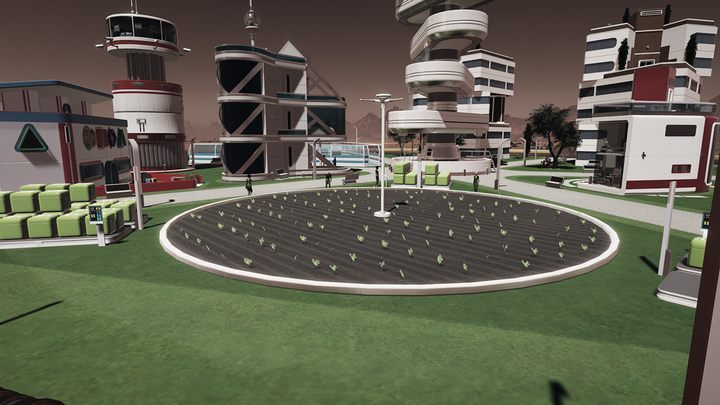Surviving Mars: Food production
Last update:
Some valuable tips & hints for your food production Mr Martian Farmer.
Which farms should I build?
You produce food on farms. There are 3 types of farms: hydroponic farms, farms, and fungal farms. Remember to assign botanists to your farms.
Fungal farms will always produce only 5 food units, and what makes them different from other farms is that you can build them outside of domes. They are not too efficient in comparison to other farms.
Focus on traditional farms and hydroponic farms. Traditional farms are the most efficient ones - they can produce up to 80 food units. However, they require a lot of space in your dome and consume a lot of water.

Hydroponic farms are a good choice at the beginning of the game because you won't have access to other farms. They use very little water and certain plants can generate oxygen.

What to harvest?
In terms of productivity of traditional farms, corn, fruit, and potatoes seem to be the best choice. However, both corn and potatoes will cause soil depletion. You can make up for it, by growing soy twice per cycle (+10% soil quality) and ground-cover plants once per cycle (+40% soil quality). You don't need to worry about higher water consumption - it's the most common resource that you can find on Mars and several water extractors can be built next to a single source.
Hydroponic farms - rice, vegetables and deciduous crops offer the highest productivity. Draw attention to algae, as they generate some oxygen - this may come in handy when you suddenly run out of oxygen. Keep in mind that you have to process your food - colonists may be unhappy that they have to eat unprocessed food. Build canteens.
Crops
Hydroponic Farms
Name | Description |
Rice | Great productivity, slow growth, higher water consumption. Water consumption: 0.9, Growth time: 4 Sole, Harvest: 14 food, Oxygen production: 0.1 |
Deciduous crops | Good productivity, slow growth. Water consumption: 0.6, Growth time: 4 Sol, Harvest: 10 food, Oxygen production: 0.1. |
Sprouts | Low productivity, slow growth, lower water consumption. Water consumption: 0.3, Growth time: 4 Sol, Harvest: 8 food, Oxygen production: 0.1. |
Vegetables | Good productivity, slow growth, lower water consumption. Water consumption: 0.5, Growth time: 4 Sol, Harvest: 12 food, Oxygen production: 0.1. |
Algae | Very low productivity, produces oxygen. Water consumption: 0.6, Growth time: 1 Sol, Harvest: 2 food, Oxygen production: 1. |
Brown algae | Medium productivity, very fast growth, produces oxygen. Water consumption: 0.6, Growth time: 1 Sol, Harvest: 3 food, Oxygen production: 0.5. |
Quitch | Low productivity, very fast growth. Water consumption: 0.6, Growth time: 1 Sol, Harvest: 2 food, Oxygen production: 0.1. |
Farms
Name | Description |
Quinoa | Medium productivity, fast growth, Lower water consumption. Water consumption: 1.6, Growth time: 2 Sol, Harvest: 20 food, Oxygen production: 0.3. |
Wheat | Low productivity, very fast growth, Lower water consumption. Water consumption: 1.6, Growth time: 2 Sol, Harvest: 14 food, Oxygen production: 0.3. |
Corn | Great productivity, slow growth, soil depletion - reduces productivity of further crops. Water consumption: 3, Growth time: 5 Sol, Harvest: 65 food, Oxygen production: 0.3, soil quality deterioration: 10%. |
Fruit | Good productivity, very slow growth, improves soil quality. Water consumption: 2.4, Growth time: 8 Sol, Harvest: 80 food, Oxygen production: 1, soil improvement: 10%. |
Potatoes | Good productivity, slow growth, soil depletion. Water consumption: 2.4, Growth time: 5 Sol, Harvest: 45 food, Oxygen production: 0.3, soil quality deterioration: 10%. |
Ground-cover plants | Very Low productivity, significantly improves soil quality. Water consumption: 2.4, Growth time: 5 Sol, Harvest: 12 food, Oxygen production: 0.3, Soil improvement: 40%. |
Soy | Low productivity, slow growth, improves soil quality. Water consumption: 2, Growth time: 5 Sol, Harvest: 34 food, Oxygen production: 0.3, Soil improvement: 10%. |
Large-scale farms
Large-scale farming is a technology from the breakthrough tree - this is the best technology you can obtain within the field of food production. For example, instead of corn providing 65 food, you can grow large corn providing 100 food.
Hydroponic farm
Name | Description |
Large rice | Excellent yield, slow growth, larger water consumption. Water consumption: 0,9, Time to grow: 4 Soli, Optimum harvest: 18 food, Oxygen production: 0.1. |
Large deciduous farming | Good yield, slow growth. Water consumption: 0,6, Time to grow: 4 Soli, Optimum harvest: 15 food, Oxygen production: 0.1. |
Large couch grass | Low yield, very fast growth. Water consumption: 0,6, Time to grow: 1 Soli, Optimum harvest: 3 food, Oxygen production: 0.1. |
Farmland
Name | Description |
Giant wheat | Low yield, very fast growth, lower water consumption. Water consumption: 1,6, Time to grow: 2 Soli, Optimum harvest: 18 food, Oxygen production: 0.3. |
Giant corn | Excellent yield, slow growth and soil impoverishment. Water consumption: 3, Time to grow: 5 Soli, Optimum harvest: 100 food, Oxygen production: 0.3. Drop in soil quality: 10%. |
Giant potatoes | Good yield, slow growth, soil impoverishment. Water consumption: 2,4, Time to grow: 5 Sols, Optimum harvest: 68 food, Oxygen production: 0.3. Drop in soil quality: 10% |
You are not permitted to copy any image, text or info from this page. This site is not associated with and/or endorsed by the developers and the publishers. All logos and images are copyrighted by their respective owners.
Copyright © 2000 - 2025 Webedia Polska SA for gamepressure.com, unofficial game guides, walkthroughs, secrets, game tips, maps & strategies for top games.
